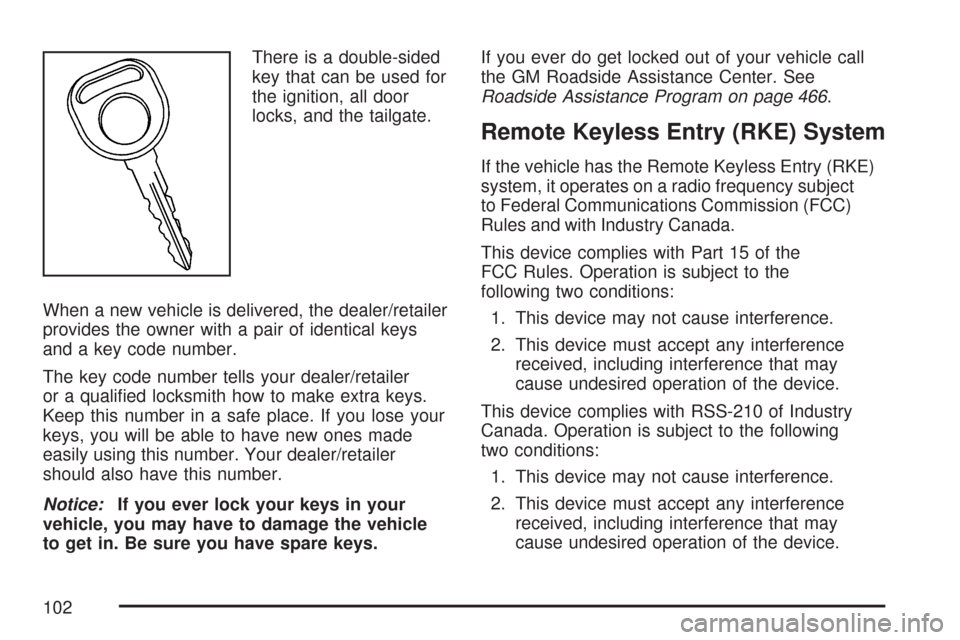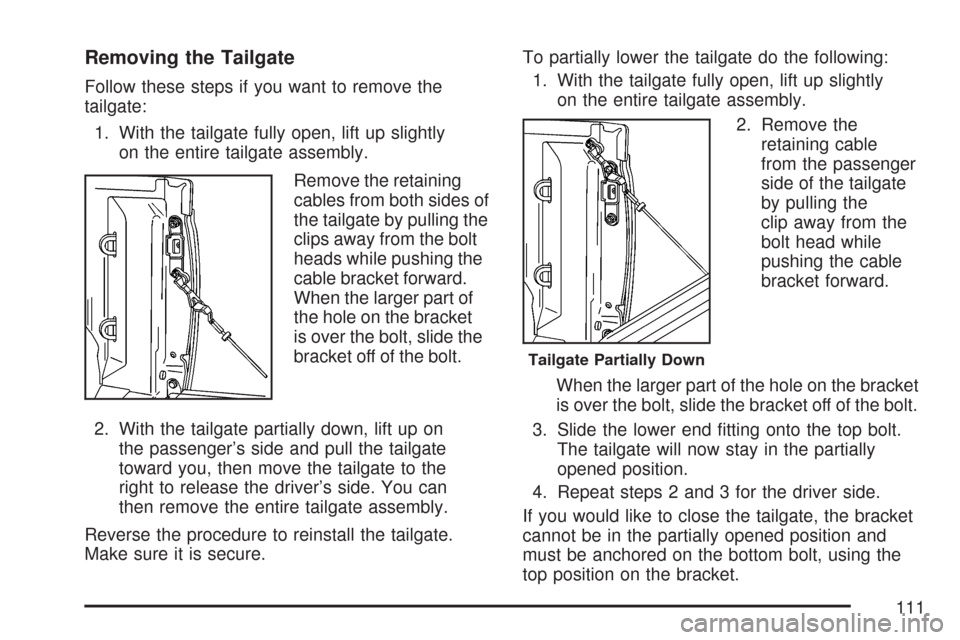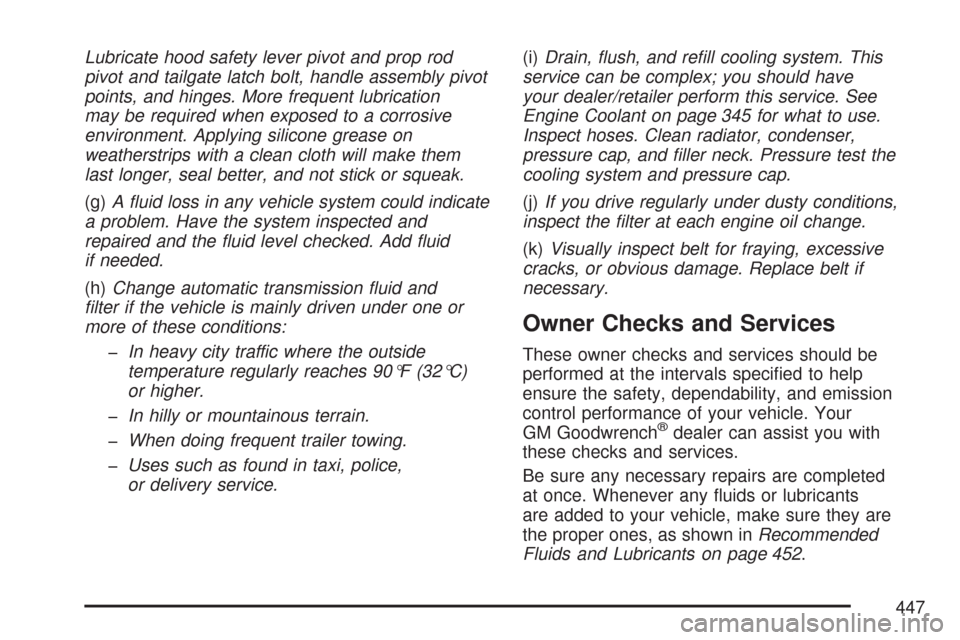2007 CHEVROLET COLORADO tailgate
[x] Cancel search: tailgatePage 20 of 496

Safety Belts
Safety Belts: They Are for Everyone
This part of the manual tells you how to use
safety belts properly. It also tells you some things
you should not do with safety belts.
{CAUTION:
It is extremely dangerous to ride in a
cargo area, inside or outside of a vehicle.
This includes riding on the tailgate, even
when the vehicle is operated at low
speeds. In a collision, people riding in
these areas are more likely to be seriously
injured or killed. People riding on the
tailgate can easily lose their balance and
fall in response to vehicle maneuvers.
Falling from a moving vehicle may result
in serious injuries or death.
Do not allow people to ride in, or on, any
area of your vehicle that is not equipped
with seats and safety belts. Be sure
everyone in your vehicle is in a seat
and using a safety belt properly.
20
Page 99 of 496

Keys............................................................ 101
Remote Keyless Entry (RKE) System........ 102
Remote Keyless Entry (RKE)
System Operation.................................. 103
Doors and Locks........................................ 106
Door Locks................................................ 106
Power Door Locks..................................... 107
Programmable Automatic
Door Locks............................................ 108
Rear Door Security Locks (Crew Cab)....... 108
Lockout Protection..................................... 109
Rear Doors (Extended Cab)...................... 109
Tailgate..................................................... 110
Windows...................................................... 112
Manual Windows....................................... 112
Power Windows........................................ 113
Sliding Rear Window................................. 114
Sun Visors................................................ 115
Theft-Deterrent Systems............................. 115
Content Theft-Deterrent............................. 115
Passlock
®.................................................. 117Starting and Operating Your Vehicle......... 118
New Vehicle Break-In................................ 118
Ignition Positions....................................... 119
Retained Accessory Power (RAP)............. 121
Starting the Engine.................................... 121
Engine Coolant Heater.............................. 123
Automatic Transmission Operation............. 124
Manual Transmission Operation................. 126
Four-Wheel Drive...................................... 129
Parking Brake........................................... 133
Shifting Into Park (P)
(Automatic Transmission)....................... 135
Shifting Out of Park (P)
(Automatic Transmission)....................... 137
Parking Your Vehicle
(Manual Transmission)........................... 137
Parking Over Things That Burn................. 138
Engine Exhaust......................................... 139
Running the Engine While Parked............. 140
Section 2 Features and Controls
99
Page 102 of 496

There is a double-sided
key that can be used for
the ignition, all door
locks, and the tailgate.
When a new vehicle is delivered, the dealer/retailer
provides the owner with a pair of identical keys
and a key code number.
The key code number tells your dealer/retailer
or a quali�ed locksmith how to make extra keys.
Keep this number in a safe place. If you lose your
keys, you will be able to have new ones made
easily using this number. Your dealer/retailer
should also have this number.
Notice:If you ever lock your keys in your
vehicle, you may have to damage the vehicle
to get in. Be sure you have spare keys.If you ever do get locked out of your vehicle call
the GM Roadside Assistance Center. See
Roadside Assistance Program on page 466.
Remote Keyless Entry (RKE) System
If the vehicle has the Remote Keyless Entry (RKE)
system, it operates on a radio frequency subject
to Federal Communications Commission (FCC)
Rules and with Industry Canada.
This device complies with Part 15 of the
FCC Rules. Operation is subject to the
following two conditions:
1. This device may not cause interference.
2. This device must accept any interference
received, including interference that may
cause undesired operation of the device.
This device complies with RSS-210 of Industry
Canada. Operation is subject to the following
two conditions:
1. This device may not cause interference.
2. This device must accept any interference
received, including interference that may
cause undesired operation of the device.
102
Page 110 of 496

Tailgate
{CAUTION:
It is extremely dangerous to ride on the
tailgate, even when the vehicle is operated
at low speeds. People riding on the
tailgate can easily lose their balance and
fall in response to vehicle maneuvers.
Falling from a moving vehicle may result
in serious injuries or death. Do not allow
people to ride on the tailgate. Be sure
everyone in your vehicle is in a seat and
using a safety belt properly.You can open the tailgate by pulling up on the
outside handle while pulling the tailgate down.
When you put the tailgate back up, be sure
it latches securely.
You can lock the tailgate using your ignition key.
Turn the key counterclockwise to lock the
tailgate. Turn the key clockwise to unlock the
tailgate.
110
Page 111 of 496

Removing the Tailgate
Follow these steps if you want to remove the
tailgate:
1. With the tailgate fully open, lift up slightly
on the entire tailgate assembly.
Remove the retaining
cables from both sides of
the tailgate by pulling the
clips away from the bolt
heads while pushing the
cable bracket forward.
When the larger part of
the hole on the bracket
is over the bolt, slide the
bracket off of the bolt.
2. With the tailgate partially down, lift up on
the passenger’s side and pull the tailgate
toward you, then move the tailgate to the
right to release the driver’s side. You can
then remove the entire tailgate assembly.
Reverse the procedure to reinstall the tailgate.
Make sure it is secure.To partially lower the tailgate do the following:
1. With the tailgate fully open, lift up slightly
on the entire tailgate assembly.
2. Remove the
retaining cable
from the passenger
side of the tailgate
by pulling the
clip away from the
bolt head while
pushing the cable
bracket forward.
When the larger part of the hole on the bracket
is over the bolt, slide the bracket off of the bolt.
3. Slide the lower end �tting onto the top bolt.
The tailgate will now stay in the partially
opened position.
4. Repeat steps 2 and 3 for the driver side.
If you would like to close the tailgate, the bracket
cannot be in the partially opened position and
must be anchored on the bottom bolt, using the
top position on the bracket.
Tailgate Partially Down
111
Page 373 of 496

5. Insert the bulb socket into the lamp assembly
and turn it clockwise to secure.
6. Reinstall the lamp assembly and tighten
the screws.
Taillamps, Turn Signal, Stoplamps
and Back-up Lamps
A. Stoplamp/Taillamp
B. Turn Signal/Taillamp
C. Back-up Lamp
To replace one of these bulbs:
1. Open the tailgate.
SeeTailgate on page 110
for more information.2. Remove the
two rear lamp
assembly
screws near the
tailgate latch.
3. Pull the lamp assembly away from the vehicle.
4. Turn the bulb socket counterclockwise to
remove it from the taillamp assembly.
5. Holding the socket, pull the old bulb to
release it from the socket.
6. Push the new bulb into the socket until it clicks.
7. Insert the bulb socket into the taillamp
assembly and turn it clockwise to secure.
8. Reinstall the taillamp assembly and tighten
the screws.
9. Close the tailgate.
373
Page 447 of 496

Lubricate hood safety lever pivot and prop rod
pivot and tailgate latch bolt, handle assembly pivot
points, and hinges. More frequent lubrication
may be required when exposed to a corrosive
environment. Applying silicone grease on
weatherstrips with a clean cloth will make them
last longer, seal better, and not stick or squeak.
(g)A �uid loss in any vehicle system could indicate
a problem. Have the system inspected and
repaired and the �uid level checked. Add �uid
if needed.
(h)Change automatic transmission �uid and
�lter if the vehicle is mainly driven under one or
more of these conditions:
�In heavy city traffic where the outside
temperature regularly reaches 90°F (32°C)
or higher.
�In hilly or mountainous terrain.
�When doing frequent trailer towing.
�Uses such as found in taxi, police,
or delivery service.(i)Drain, �ush, and re�ll cooling system. This
service can be complex; you should have
your dealer/retailer perform this service. See
Engine Coolant on page 345 for what to use.
Inspect hoses. Clean radiator, condenser,
pressure cap, and �ller neck. Pressure test the
cooling system and pressure cap.
(j)If you drive regularly under dusty conditions,
inspect the �lter at each engine oil change.
(k)Visually inspect belt for fraying, excessive
cracks, or obvious damage. Replace belt if
necessary.
Owner Checks and Services
These owner checks and services should be
performed at the intervals speci�ed to help
ensure the safety, dependability, and emission
control performance of your vehicle. Your
GM Goodwrench
®dealer can assist you with
these checks and services.
Be sure any necessary repairs are completed
at once. Whenever any �uids or lubricants
are added to your vehicle, make sure they are
the proper ones, as shown inRecommended
Fluids and Lubricants on page 452.
447
Page 453 of 496

Usage Fluid/Lubricant
Transfer CaseSynchromesh Transmission Fluid
(GM Part No. U.S. 12345349,
in Canada 10953465).
Rear Driveline
Center Spline
and Universal
JointsChassis Lubricant
(GM Part No. U.S. 12377985, in
Canada 88901242) or lubricant
meeting requirements of NLGI #2,
Category LB or GC-LB.
Constant
Velocity
Universal JointChassis Lubricant
(GM Part No. U.S. 12377985, in
Canada 88901242) or lubricant
meeting requirements of NLGI #2,
Category LB or GC-LB.
Hood Latch
Assembly,
Secondary
Latch,
Pivots, Spring
Anchor, and
Release PawlLubriplate Lubricant Aerosol
(GM Part No. U.S. 12346293, in
Canada 992723) or lubricant
meeting requirements of NLGI #2,
Category LB or GC-LB.Usage Fluid/Lubricant
Hood and
Door Hinges,
Body Door
Hinge Pins,
Liftgate Hinge
and Linkage,
Folding Seats,
and Fuel
Door HingeMulti-Purpose Lubricant, Superlube
(GM Part No. U.S. 12346241,
in Canada 10953474).
Outer Tailgate
Handle Pivot
Points and
HingesMulti-Purpose Lubricant, Superlube
(GM Part No. U.S. 12346241,
in Canada 10953474).
Weatherstrip
ConditioningWeatherstrip Lubricant
(GM Part No. U.S. 3634770,
in Canada 10953518) or
Dielectric Silicone Grease
(GM Part No. U.S. 12345579,
in Canada 992887).
Weatherstrip
SqueaksSynthetic Grease
with Te�on, Superlube
(GM Part No. U.S. 12371287,
in Canada 10953437).
453